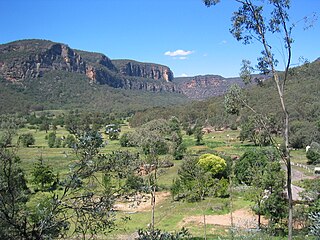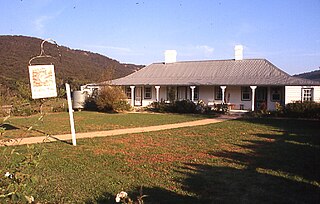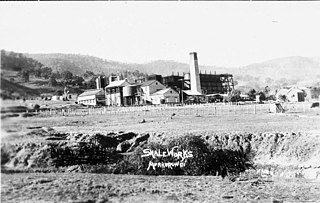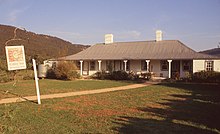
Hartley is a historical village in the Central West region of New South Wales, Australia, within the City of Lithgow local government area, located approximately 127 kilometres (79 mi) west of Sydney. Hartley is located below the western escarpment of the Blue Mountains.

Glen Davis is a village in the Central Tablelands of New South Wales, Australia. The village is located in the local government area of the City of Lithgow. It is located 250 km north-west of Sydney and approximately 80 kilometres north of Lithgow. The name is also applied to the surrounding area, for postal and statistical purposes. In the 2006 census, Glen Davis had a population of 354 but this fell to 115 in the 2016 census, and declined still further to 106 at the 2021 census.
Marrangaroo is a village in the Central West of New South Wales, Australia in the City of Lithgow. The name is also applied to the surrounding area, for postal and statistical purposes.

The City of Lithgow is a local government area in the Central West region of New South Wales, Australia. The area is located adjacent to the Great Western Highway and the Main Western railway line.

Joadja is a historic town, now in ruins, in the Southern Highlands of New South Wales, Australia, in Wingecarribee Shire. The remnants of the town were added to the New South Wales State Heritage Register on 5 November 1999.

Mount York, a mountain in the western region of the Explorer Range, part of the Blue Mountains Range that is a spur off the Great Dividing Range, is located approximately 150 kilometres (93 mi) west of Sydney, just outside Mount Victoria in New South Wales, Australia. Mount York has an elevation of 1,061 metres (3,481 ft) AHD and is a projection of the Blue Mountains dissected plateau, creating a promontory of the western escarpment with a minor rise at its summit.

The Capertee Valley is a large canyon in New South Wales, Australia, 135 km (84 mi) north-west of Sydney that is noted to be the second widest of any canyon in the world, exceeding the Grand Canyon. It is located 135 km (84 mi) kilometres north-west of Sydney, between Lithgow and Mudgee, in the Central Tablelands, just above the Blue Mountains.
Kerosene Vale is a historic locality within the City of Lithgow Local Government Area of New South Wales, Australia. Kerosene Vale lies near Lidsdale and Wallerawang. It is considered part of Lidsdale for census purposes. It should not be confused with Hartley Vale, another locality with a history of shale oil production, which is also within the City of Lithgow. The name Kerosene Vale is now only used infrequently.
There are oil shale deposits in Australia which range from small deposits to large reserves. Deposits, varying by their age and origin, are located in about a third of eastern Australia. In 2012, the demonstrated oil shale reserves were estimated at 58 billion tonnes. The easiest to recover deposits are located in Queensland.

The Glen Davis Shale Oil Works was a shale oil extraction plant, in the Capertee Valley, at Glen Davis, New South Wales, Australia, which operated from 1940 until 1952. It was the last oil-shale operation in Australia, until the Stuart Oil Shale Project in the late 1990s. For the period of 1965–1952, it provided one fifth of the shale oil produced in Australia.
Commonwealth Oil Corporation Limited was a British-owned Australian company associated with the production and refining of petroleum products derived from oil shale, during the early years of the 20th century. It is associated with Newnes, Hartley Vale, and Torbane, all in New South Wales. It should not be confused with Commonwealth Oil Refineries, which was a completely separate company, established in 1920, that refined imported crude oil from 1924.

Collits' Inn is a heritage-listed former inn and now functions, accommodation and restaurant at Hartley Vale Road, Hartley Vale in the Central West region of New South Wales, Australia. It was designed by Pierce Collits and built in 1823. It is also known as Collitts Inn and Golden Fleece Inn. It was added to the New South Wales State Heritage Register on 2 April 1999.
Torbane was a privately-owned village lying within the area now known as Capertee, in the Local Government Area of the City of Lithgow, within the Central West region of New South Wales, Australia. There was also another village, Airly, nearby. Both villages were associated with the mining of oil shale. The mine associated with Torbane was known as the New Hartley Mine. and that associated with Airly was known as the Genowlan Mine. There were retorts that produced crude shale oil at Torbane. Both Torbane and Airly are now ghost towns.

John Wilson Fell (1862–1955) was an industrialist involved in the shale oil operations at Newnes, New South Wales and the establishment of two early oil refineries, on Gore Bay at Greenwich and at Clyde, both suburbs of Sydney. He was the principal of John Fell & Company and was, for many years, the Managing Director of Commonwealth Oil Corporation, which he revived from receivership.

The British Australian Oil Company Limited was a British-owned company—incorporated in 1910—that mined oil shale and produced shale oil and refined oil products, in New South Wales, Australia, during the years from 1911 to 1915.
The New South Wales Shale and Oil Company — established in 1872, by the merging of two earlier ventures — mined and processed oil shale to produce kerosene, paraffin wax and candles, and other petroleum products, in New South Wales Australia. It is particularly associated with the sites of its former works, at Hartley Vale and Torbane. Its assets were bought by Commonwealth Oil Corporation in 1906.
Australian Kerosene Oil Company or 'A.K.O' mined and processed oil shale to produce kerosene, paraffin wax and candles, lubricating oil and greases, and other petroleum-based products, in New South Wales Australia. It is particularly associated with the site of its mine and works, at Joadja. At times, it also had other mining operations, at Airly and near Katoomba, and a soap and candle factory at Camellia. The company used the brand name 'Southern Cross' for its kerosene products.
Lidsdale is a locality within the City of Lithgow Local Government Area of New South Wales, Australia. It lies to the north of Wallerawang. Its area, as defined for postal and statistical purposes, includes the historic locality of Kerosene Vale and the small rural areas known as Springvale and Angus Place. In 2021, its population was 471.














